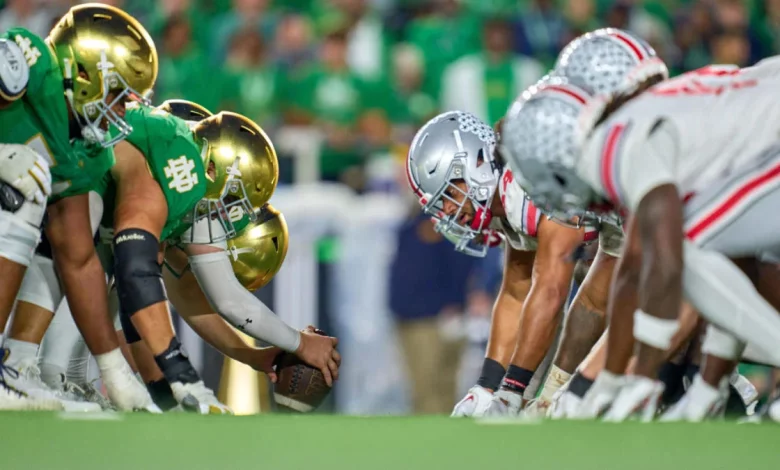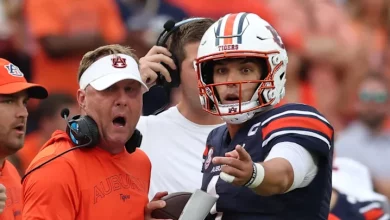Historical and contemporary: Ohio State and Notre Dame, two traditional powers, have changed

When you think of college football, two programs that come to mind are Ohio State University and the University of Notre Dame. Both teams have long, storied histories, filled with remarkable achievements and passionate fanbases. These two programs have been among the most successful in the history of the sport, with countless victories, national championships, and legendary players. But as college football continues to evolve, so too do these iconic institutions. From their early days to their modern successes, both Ohio State and Notre Dame have undergone significant changes—both in terms of their on-field performance and off-field operations. Let’s take a deep dive into how these traditional powerhouses have changed over the years, from their historical roots to their contemporary evolution in the world of college football.
Early Beginnings: Establishing Traditions
Notre Dame: The Birth of a Dynasty
Notre Dame’s football program dates back to 1887, and the team quickly became synonymous with the idea of college football excellence. The Fighting Irish’s rise began under the leadership of coach Knute Rockne in the 1920s. Rockne, one of the most famous names in college football history, was instrumental in creating a national identity for Notre Dame football. Under his leadership, the team won several national championships and developed a reputation for its fighting spirit and innovative style of play.
Rockne’s influence on the sport extended beyond just winning games. He popularized the forward pass, which revolutionized college football and set the stage for modern offenses. Notre Dame’s success on the field, combined with Rockne’s personal charisma and coaching prowess, made the Fighting Irish a household name in America. The program’s success continued throughout the 1930s and 1940s, with Notre Dame cementing itself as one of the top programs in college football.
Throughout much of the 20th century, Notre Dame was synonymous with success and tradition. The university built a loyal fanbase, not only in Indiana but across the United States. Its fight song, “Notre Dame, Our Mother,” became iconic, and the golden helmets became a symbol of the team’s tradition. Notre Dame’s success on the field was also accompanied by a sense of integrity and pride, with the university emphasizing the importance of academics and character in its athletes.
Ohio State: Rising to Prominence
Ohio State’s football program also has its roots in the early 20th century, with the Buckeyes playing their first season in 1890. The team gained prominence in the 1950s under head coach Woody Hayes, who revolutionized Ohio State football and led the program to national prominence. Hayes was known for his disciplined, run-heavy offense and for developing a culture of toughness and hard work. Under Hayes, Ohio State captured three national championships in the 1960s (1961, 1968, and 1970), solidifying itself as one of the premier football programs in the nation.
Hayes was not only a great coach, but he also created the “Ohio State way,” a philosophy that prioritized team-first mentality, discipline, and relentless work ethic. His rivalry with Michigan, one of the most storied in college football, became a defining feature of Ohio State football. Hayes’ tenure at Ohio State continued through the 1970s until the mid-1980s, leaving a legacy that would be difficult for any coach to follow.
The rise of Ohio State coincided with the growing popularity of college football as a national sport. While the Buckeyes had strong roots in the Big Ten Conference, their dominance on the field expanded their reach and made them a national powerhouse. Ohio State’s success was also propelled by a deep pipeline of talent from the state of Ohio, which has long been a hotbed for high school football.
The Shift: Changing Coaches and the Expansion of the Game
Notre Dame: A Period of Transition
As college football entered the 1980s and 1990s, Notre Dame, despite still being a respected program, began to face some challenges. While the Fighting Irish had moments of brilliance—such as winning the 1988 national championship under head coach Lou Holtz—the program struggled to maintain consistent success through the next few decades. The school also faced challenges due to its independent status in an increasingly conference-driven world.
Notre Dame’s independence, which had historically been one of the program’s strengths, started to become a disadvantage as the NCAA and other major schools began to align themselves into conferences for scheduling purposes. Without a conference affiliation, Notre Dame had to arrange games against teams across the country, and it didn’t always have the same competitive advantages that other programs did in terms of conference rivalries and scheduling ease.
Despite these challenges, Notre Dame remained an attractive destination for top-tier recruits, largely due to its tradition and the prestige of playing for the Fighting Irish. The hiring of Bob Davie in the late 1990s was an attempt to recapture the program’s previous glory, but Notre Dame continued to experience inconsistency, with only brief flashes of national championship contention.
The hiring of Charlie Weis in 2005 brought renewed hope, as Weis had come from a successful tenure as the offensive coordinator at the New England Patriots. However, even with a high-profile coaching staff, Notre Dame’s struggles continued. Weis’ tenure did not yield the results many had hoped, and by 2009, the program found itself in need of another transition.
The arrival of Brian Kelly in 2010 marked a new era for Notre Dame. Kelly’s ability to recruit and adapt to the modern game began to restore Notre Dame’s competitiveness. In 2012, Notre Dame reached the national championship game, but despite their undefeated season, the team was defeated by Alabama in the final. Kelly’s approach focused on blending traditional values with modern innovations in offensive and defensive strategies, and he managed to guide the team back into the upper echelons of college football.
Ohio State: Sustaining Success
For Ohio State, the transition from the legendary Woody Hayes to future coaches like Earle Bruce, John Cooper, and Jim Tressel did not result in any major falloff in success. In fact, the program remained a dominant force in the Big Ten throughout the 1980s and 1990s. Under Jim Tressel, Ohio State enjoyed its most sustained period of success, winning the national championship in 2002 and regularly appearing in major bowl games.
However, the 2010s brought new challenges to the Buckeyes. Jim Tressel’s resignation in 2011 due to NCAA violations shook the program, but the hiring of Urban Meyer quickly restored the team to national prominence. Meyer, who had previously won two national championships with the University of Florida, brought a more modern, high-octane offense to Ohio State. Under Meyer, the Buckeyes won the first-ever College Football Playoff National Championship in 2014, and Ohio State remained a perennial contender under his leadership.
Urban Meyer’s departure after the 2018 season led to the hiring of Ryan Day, who had been an offensive coordinator under Meyer. Day’s immediate success was notable, as he guided Ohio State to a College Football Playoff appearance in 2019 and nearly led the team to another championship. The program continued its dominance in recruiting, bringing in top-tier talent year after year, and the Buckeyes became synonymous with high-scoring offenses and elite defense.
Contemporary Landscape: The Changing Nature of College Football
Today, both Ohio State and Notre Dame are competitive powerhouses, but the landscape of college football has changed in several key ways. One of the most significant changes is the advent of the College Football Playoff (CFP), which has revolutionized how teams qualify for the national championship. While Notre Dame continues its tradition of independence, it is now a member of the ACC in most sports, including football, for scheduling purposes, allowing them a more consistent path to the playoff. Ohio State, on the other hand, continues to compete in the Big Ten and is a regular contender for the CFP.
Both programs have adapted to the modern age by emphasizing high-powered offenses, advanced analytics, and cutting-edge recruiting methods. The NIL (Name, Image, Likeness) era has also played a major role in shaping college football, as recruits now have the ability to profit from their personal brand. Ohio State and Notre Dame are both taking advantage of this new reality, ensuring that they can remain competitive in the ever-evolving world of college football.









